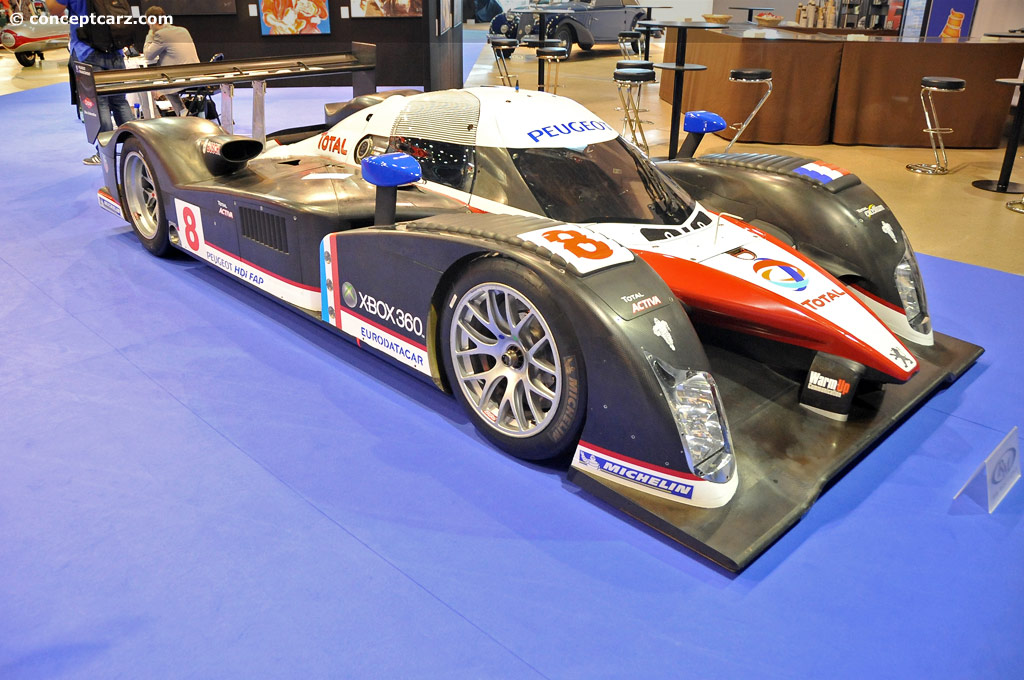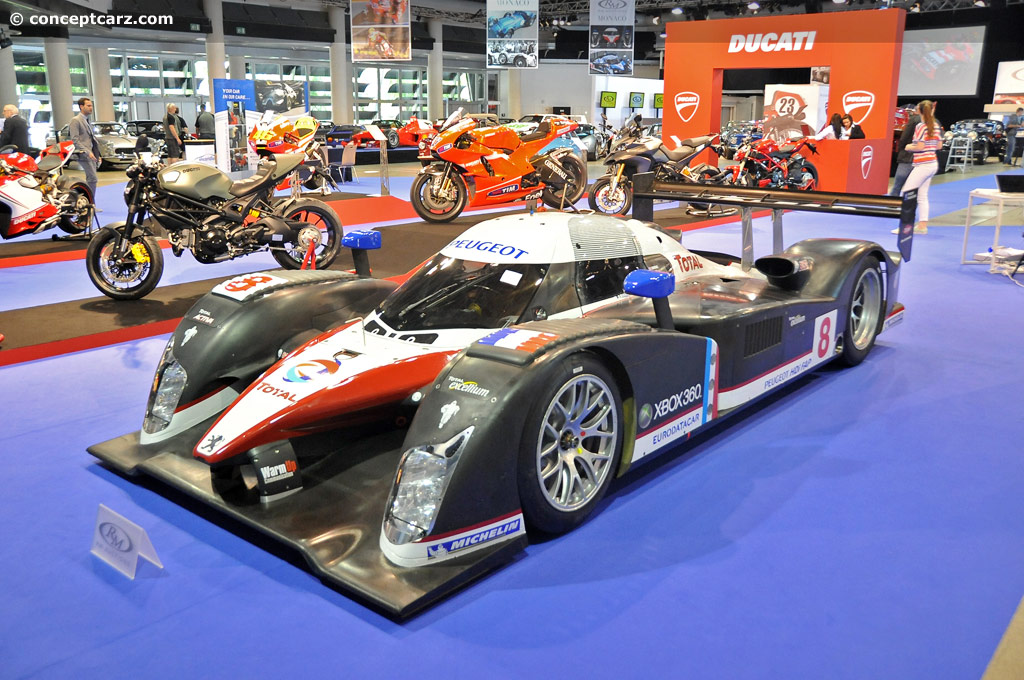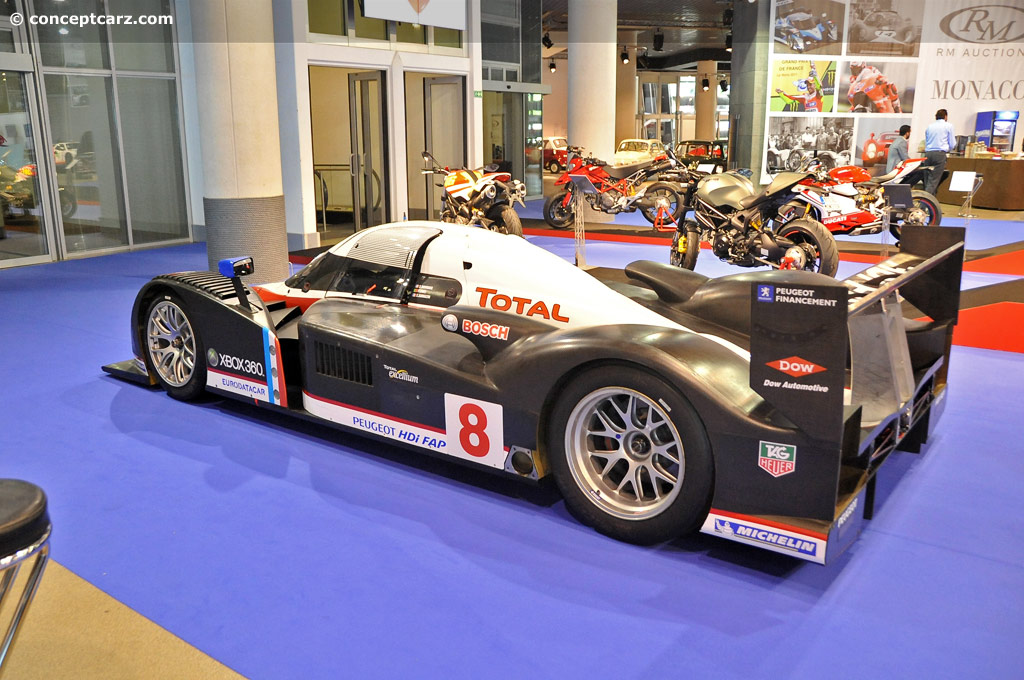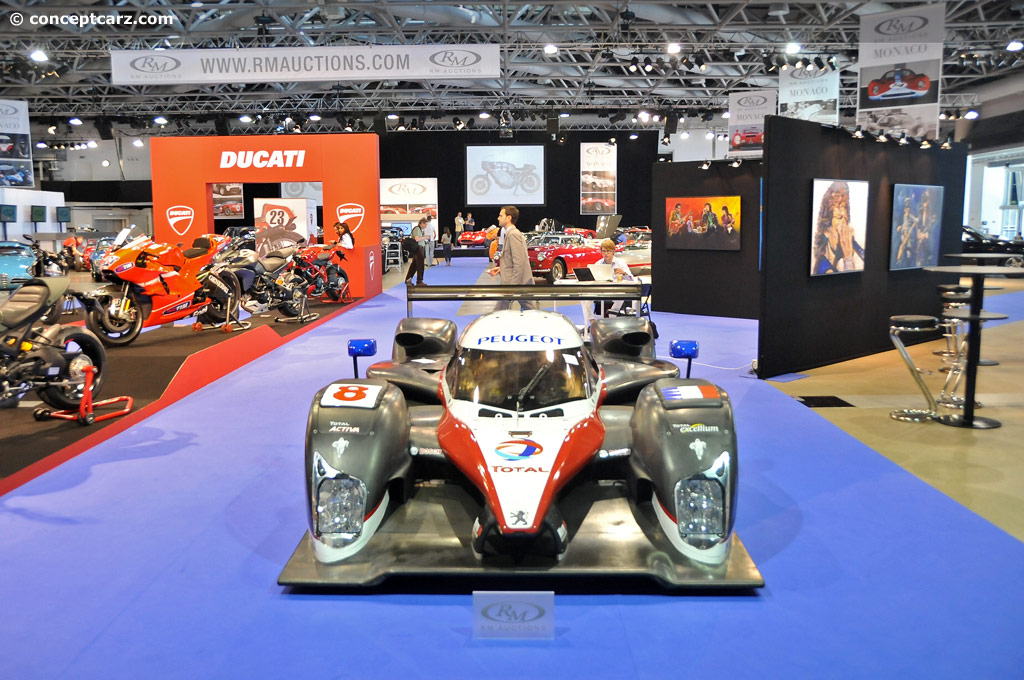Image credit: © conceptcarz.com (Reproduction Or reuse prohibited).

Heading into the 2007 24 Hours of Le Mans there was a renewed sense of excitement and anticipation surrounding the endurance classic. The previous year had seen the new turbo-diesel developed by Audi Sport dominate the competition to take the overall victory in its maiden attempt. The reason for the excitement was simple: Peugeot was back and it was coming back with a powerful diesel of its own. Audi had a challenger and it came in the form of the 908 HDi FAP.
Originally conceived in 2005, the 908 project would start rather quietly despite Bruno Famin coming to the team becoming the Technical Director of the program. Besides Famin, Paolo Catone and Guillaume Cattelani would also join the team to begin the process of laying the groundwork for Peugeot's expected return to Le Mans in 2007.
By January of 2006 the car's basic outline and concept would be agreed upon. Finally, in June of the same year Peugeot would formally announce their intentions and would unveil the project to the public with a full scale concept car.
About the same time the concept car had been unveiled to the public, aerodynamicist Cattelani would be hard at work outlining the actual car that would hopefully take the fight back to Audi and give France its first overall champion in well over a decade. More than 500 hours of honing would go into the overall design of the car. In fact, the majority of the car's shape would already be determined by the time the concept model made the rounds. What the public didn't realize at the time was the real full scale car would look quite different from the concept. But still, some of the major elements were still very much a part of the car including the raised nose, the swept sidepods trailing detached wheel housings and, of course, the closed cockpit.
At the same time the car was being finalized, work continued on the diesel powerplant that would enable it to take the fight to Audi over the course of 24 hours. One major factor in the design of the engine, surprisingly, would be its weight. Diesel engine cylinder heads are quite burdensome due to the high cylinder pressures. This would affect handling given the positioning of the cylinders. The sought after positioning would be low towards the ground in order to maintain a low center of gravity. Therefore, a 100 degree V-pattern would be the desired design. In order to achieve the goal, the engine team would start out designing a single cylinder and building from there. What would result would be a 5.5-liter turbo diesel capable of producing very little sound and more than 700 bhp. Of course, it would be the torque figures that would end up making the greatest impact on any race. And in the case of the 5.5-liter engine, the torque figure would be well in excess of 885 foot-pounds.
With the two major elements in place, it was time to join them together and actually build them. Construction would begin in 2006 with the first unit being finished late in 2006. The design of the chassis would be a very important feature, not only for aerodynamics and handling, but also, for rigidity and strength. Instead of a tub, the carbon fiber monocoque body would not only provide the shape of the car, but also, would provide great strength and rigidity than previous tub designs.
The design would make use of electric power steering, carbon brakes and independent front and rear suspension utilizing pushrods, torsion bars and adjustable dampers. The car would feature a limited-slip differential; a cerametallic, multi-plate clutch and a longitudinal 6 speed gearbox capable of handling the incredible torque produced by the diesel engine.
A 908 HDI FAP would take to the track for the first time in December of 2006. The car would be in the hands of Eric Helary and would take place at Villacoublay, which is near Paris, France. The presentation of the actual car would then take place in January of 2007 with drivers Sebastien Bourdais, Marc Gene, Eric Helary, Pedro Lamy, Nicolas Minassian, Stephane Sarrazin and Jacques Villeneuve all being present.
The car would immediately prove itself with a 1st and 3rd at the 1000km of Monza. Victories in the 1000km of Valencia, the 1000km of Nurburgring and the 1000km of Spa would make it four consecutive victories in as many races. In total, the Peugeot 908 HDi FAP would enjoy six victories throughout the 2007 season. Unfortunately, the one that really mattered, the 24 Hours of Le Mans, would escape the 908 in 2007. In fact, chassis 03 would be the best finisher ending the race in 2nd place but some 10 laps behind.
Still, the 908 presented the greatest challenge Audi faced in more than half a decade. Eventually the 908 would take and impressive one-two victory in the 2009 24 Hours of Le Mans. The best Audi would end up in 3rd place some 6 laps behind the overall winner.
One of those initial 908s that was presented the challenge of taking the fight back to Audi would be chassis # 02. And for the first time, a Peugeot 908 HDi FAP would be offered for private ownership. Chassis 02, the very same chassis that earned overall victories in no fewer than six races, would be offered via RM Auctions event held at the Grimaldi Forum in Monaco in May of 2012.
Chassis 02 would go on to earn some impressive victories. It would give Peugeot and the 908 its first victory when it won the 1000km of Monza in April of 2007. It would then earn back-to-back victories in the 1000km of Silverstone and Mil Milhas Brasileiras at the end of the season. In 2008, chassis 02 would go on to win the 2008 1000km Catalunya and the 1000km of Spa. At the 2007 24 Hours of Le Mans, chassis 02 featured a driver lineup that would include Indy 500 and Formula One World Champion Jacques Villeneuve. Therefore, had the car been successful it would have gone down in history as the car that helped Villeneuve achieve racing's 'Triple Crown'. But despite starting the race from 3rd place on the grid, chassis 02 would fail to finish the race as it would fall out with injection issues after having completed 338 laps.
Even despite its failure in the toughest motor race, chassis 02 would still go on to have checkered career and it would help to pave the way for Peugeot returning to the top of the French classic for the first time since the early 1990s.
Mean and aggressive in its looks and steeped in Le Mans and endurance racing history, not to mention being an important player in the fledgling rivalry with Audi Sport, chassis 02 certainly deserves a special place in any collection. Electronic and sporting successful diesel engine technology, Peugeot 908 chassis 02 rightly demonstrates all that Le Mans is to the automotive industry and is, in itself, a true piece of history anyone would be lucky to own.
Early estimates had the 908 HDi FAP chassis 02 valued between 1,500,000 and 1,800,000 EUR. When the bidding was done on Friday, May 12th the car would garner a sale price of 1,680,000 EUR.
Sources:
'Lot No. 382: 2007 Peugeot 908 V-12 HDI FAP Le Mans Racing Car', (http://www.rmauctions.com/CarDetails.cfm?SaleCode=MC12&CarID=r347&Currency=). RM Auctions. http://www.rmauctions.com/CarDetails.cfm?SaleCode=MC12&CarID=r347&Currency=. Retrieved 15 May 2012.
'Results of Chassis 2007 # 908-02', (http://www.racingsportscars.com/chassis/results/2007%20N%C2%B0%20908-02.html). Racing Sports Cars. http://www.racingsportscars.com/chassis/results/2007%20N%C2%B0%20908-02.html. Retrieved 15 May 2012.
'2007-2009 Peugeot 908 HDi FAP', (http://www.mulsannescorner.com/peugeot908.html). Mulsannescorner.com. http://www.mulsannescorner.com/peugeot908.html. Retrieved 15 May 2012.By Jeremy McMullen
Originally conceived in 2005, the 908 project would start rather quietly despite Bruno Famin coming to the team becoming the Technical Director of the program. Besides Famin, Paolo Catone and Guillaume Cattelani would also join the team to begin the process of laying the groundwork for Peugeot's expected return to Le Mans in 2007.
By January of 2006 the car's basic outline and concept would be agreed upon. Finally, in June of the same year Peugeot would formally announce their intentions and would unveil the project to the public with a full scale concept car.
About the same time the concept car had been unveiled to the public, aerodynamicist Cattelani would be hard at work outlining the actual car that would hopefully take the fight back to Audi and give France its first overall champion in well over a decade. More than 500 hours of honing would go into the overall design of the car. In fact, the majority of the car's shape would already be determined by the time the concept model made the rounds. What the public didn't realize at the time was the real full scale car would look quite different from the concept. But still, some of the major elements were still very much a part of the car including the raised nose, the swept sidepods trailing detached wheel housings and, of course, the closed cockpit.
At the same time the car was being finalized, work continued on the diesel powerplant that would enable it to take the fight to Audi over the course of 24 hours. One major factor in the design of the engine, surprisingly, would be its weight. Diesel engine cylinder heads are quite burdensome due to the high cylinder pressures. This would affect handling given the positioning of the cylinders. The sought after positioning would be low towards the ground in order to maintain a low center of gravity. Therefore, a 100 degree V-pattern would be the desired design. In order to achieve the goal, the engine team would start out designing a single cylinder and building from there. What would result would be a 5.5-liter turbo diesel capable of producing very little sound and more than 700 bhp. Of course, it would be the torque figures that would end up making the greatest impact on any race. And in the case of the 5.5-liter engine, the torque figure would be well in excess of 885 foot-pounds.
With the two major elements in place, it was time to join them together and actually build them. Construction would begin in 2006 with the first unit being finished late in 2006. The design of the chassis would be a very important feature, not only for aerodynamics and handling, but also, for rigidity and strength. Instead of a tub, the carbon fiber monocoque body would not only provide the shape of the car, but also, would provide great strength and rigidity than previous tub designs.
The design would make use of electric power steering, carbon brakes and independent front and rear suspension utilizing pushrods, torsion bars and adjustable dampers. The car would feature a limited-slip differential; a cerametallic, multi-plate clutch and a longitudinal 6 speed gearbox capable of handling the incredible torque produced by the diesel engine.
A 908 HDI FAP would take to the track for the first time in December of 2006. The car would be in the hands of Eric Helary and would take place at Villacoublay, which is near Paris, France. The presentation of the actual car would then take place in January of 2007 with drivers Sebastien Bourdais, Marc Gene, Eric Helary, Pedro Lamy, Nicolas Minassian, Stephane Sarrazin and Jacques Villeneuve all being present.
The car would immediately prove itself with a 1st and 3rd at the 1000km of Monza. Victories in the 1000km of Valencia, the 1000km of Nurburgring and the 1000km of Spa would make it four consecutive victories in as many races. In total, the Peugeot 908 HDi FAP would enjoy six victories throughout the 2007 season. Unfortunately, the one that really mattered, the 24 Hours of Le Mans, would escape the 908 in 2007. In fact, chassis 03 would be the best finisher ending the race in 2nd place but some 10 laps behind.
Still, the 908 presented the greatest challenge Audi faced in more than half a decade. Eventually the 908 would take and impressive one-two victory in the 2009 24 Hours of Le Mans. The best Audi would end up in 3rd place some 6 laps behind the overall winner.
One of those initial 908s that was presented the challenge of taking the fight back to Audi would be chassis # 02. And for the first time, a Peugeot 908 HDi FAP would be offered for private ownership. Chassis 02, the very same chassis that earned overall victories in no fewer than six races, would be offered via RM Auctions event held at the Grimaldi Forum in Monaco in May of 2012.
Chassis 02 would go on to earn some impressive victories. It would give Peugeot and the 908 its first victory when it won the 1000km of Monza in April of 2007. It would then earn back-to-back victories in the 1000km of Silverstone and Mil Milhas Brasileiras at the end of the season. In 2008, chassis 02 would go on to win the 2008 1000km Catalunya and the 1000km of Spa. At the 2007 24 Hours of Le Mans, chassis 02 featured a driver lineup that would include Indy 500 and Formula One World Champion Jacques Villeneuve. Therefore, had the car been successful it would have gone down in history as the car that helped Villeneuve achieve racing's 'Triple Crown'. But despite starting the race from 3rd place on the grid, chassis 02 would fail to finish the race as it would fall out with injection issues after having completed 338 laps.
Even despite its failure in the toughest motor race, chassis 02 would still go on to have checkered career and it would help to pave the way for Peugeot returning to the top of the French classic for the first time since the early 1990s.
Mean and aggressive in its looks and steeped in Le Mans and endurance racing history, not to mention being an important player in the fledgling rivalry with Audi Sport, chassis 02 certainly deserves a special place in any collection. Electronic and sporting successful diesel engine technology, Peugeot 908 chassis 02 rightly demonstrates all that Le Mans is to the automotive industry and is, in itself, a true piece of history anyone would be lucky to own.
Early estimates had the 908 HDi FAP chassis 02 valued between 1,500,000 and 1,800,000 EUR. When the bidding was done on Friday, May 12th the car would garner a sale price of 1,680,000 EUR.
Sources:
'Lot No. 382: 2007 Peugeot 908 V-12 HDI FAP Le Mans Racing Car', (http://www.rmauctions.com/CarDetails.cfm?SaleCode=MC12&CarID=r347&Currency=). RM Auctions. http://www.rmauctions.com/CarDetails.cfm?SaleCode=MC12&CarID=r347&Currency=. Retrieved 15 May 2012.
'Results of Chassis 2007 # 908-02', (http://www.racingsportscars.com/chassis/results/2007%20N%C2%B0%20908-02.html). Racing Sports Cars. http://www.racingsportscars.com/chassis/results/2007%20N%C2%B0%20908-02.html. Retrieved 15 May 2012.
'2007-2009 Peugeot 908 HDi FAP', (http://www.mulsannescorner.com/peugeot908.html). Mulsannescorner.com. http://www.mulsannescorner.com/peugeot908.html. Retrieved 15 May 2012.By Jeremy McMullen
2012 RM Auctions at Monaco
Pre-Auction Estimates :
€1,500,000-€1,800,000
Sale Price :
USD $2,170,402 (€ 1,680,000.00)
Recent Sales of the Peugeot 908 HDi FAP
(Data based on Model Year 2007 sales)
| 2007 Peugeot 908 V-12 HDi FAP Le Mans Racing Car Chassis#: 02 Sold for USD$2,170,402 2012 RM Auctions at Monaco |   |
Peugeot 908 HDi FAPs That Failed To Sell At Auction
2007 Peugeot 908 HDi FAP's that have appeared at auction but did not sell.
| Vehicle | Chassis | Event | High Bid | Est. Low | Est. High |
|---|
Vehicles With Comparable Market Values
Similar sales to the $2,170,402 range.
| 1993 Bugatti EB110 SS Prototype Chassis#:ZA9AB02X0PCD39004 Sold for $2,150,000 2024 RM Sothebys : Monterey | |
| 2022 Lamborghini Countach LPI 800-4 Chassis#:ZHWEA9ZD5NLA11184 Sold for $2,156,439 2024 RM Sothebys : Monaco | |
| 1992 Ferrari F40 Chassis#:ZFFGJ34B000094277 Sold for $2,150,000 2023 RM Sothebys : Arizona | |
| 1959 BMW 507 SERIES II Chassis#:70228 Sold for $2,150,000 2022 Gooding & Company : Amelia Island Auction |   |
| 2000 FERRARI 550 GT1 Chassis#:115811 Sold for $2,187,958 2021 RM Sothebys : Milan 2021 | |
| 1958 BMW 507 Roadster Series II Chassis#:70134 Sold for $2,191,251 2020 RM Sothebys : Paris |   |
| 1958 BMW 507 Roadster Series II Chassis#:70157 Sold for $2,175,000 2019 RM Sothebys : Scottsdale Arizona |  |
| 1971 Lamborghini Miura P400 SV by Bertone Chassis#:4920 Sold for $2,177,500 2018 RM Sothebys : Monterey |   |
| 1958 BMW 507 Roadster Series II Chassis#:70127 Sold for $2,182,327 2018 RM Sothebys : Paris | |
| 1969 Ferrari 365 GTB/4 Daytona Berlinetta Alloy by Scaglietti Chassis#:12653 Sold for $2,174,840 2017 RM Sothebys : Ferrari - Leggenda e Passione | |
| 1935 Aston Martin Ulster Competition Sports Chassis#:B5/549/U Sold for $2,172,500 2017 RM Sothebys : Monterey |   |
| 1972 Ferrari 365 GTB/4 Daytona Spider by Scaglietti Chassis#:15007 Sold for $2,172,500 2017 RM Sothebys : Monterey | |
| 1965 Ferrari 275 GTB Short Nose Chassis#:07633 Sold for $2,150,000 2014 Mecum : Anaheim | |
| 1929 Bugatti Type 35B Grand Prix Two-Seater Chassis#:37371 Sold for $2,191,440 2014 LES GRANDES MARQUES DU MONDE AU GRAND PALAIS | |
| 1934 ASTON MARTIN ULSTER TWO-SEATER SPORTS Chassis#:L4/525/U Sold for $2,173,738 2013 Bonhams : The December Sale | |
| 2007 Peugeot 908 V-12 HDi FAP Le Mans Racing Car Chassis#:02 Sold for $2,170,402 2012 RM Auctions at Monaco |   |
| 1967 Lamborghini Marzal Chassis#:10001 Sold for $2,156,747 2011 RM Auctions - Villa d'Este |  |
| 1959 Ferrari 250GT (SWB) Berlinetta Speciale Bertone Chassis#:1739 GT Sold for $2,160,048 2009 Ferrari – Leggenda e Passione |   |
| 1931 Mercedes-Benz Type SSKL Replica Chassis#:36357 Sold for $2,156,462 2007 RM Auctions - Automobiles of London |
2007 Peugeot 908 HDi FAP
• Additional valuation insight and sales data• History
• Specifications
• Image gallery








